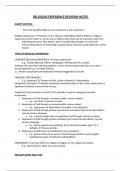RELIGIOUS EXPERIENCE REVISION NOTES
ALBERT EINSTEIN:
- “The most beautiful thing we can experience is the mysterious”.
Religious experience Peterson et al in ‘Reason and Religious Belief’ defines a religious
experience as one where a “person has or believes they have had an encounter with God”.
- Interesting because: They believe, does it include Mary/Angels? Or only God?
- They are Revelations knowledge is gained about God that would otherwise not be
known.
TYPES OF RELIGIOUS EXPEIRENCE:
CORORATE RELIGIOUS EXPERIENCE Group experiences
- E.g., Toronto Blessing, Fatima, Medjugorje, whirling dervish, Lourdes
Anthony Flew says that collecting together a series of weak arguments does not make a
strong argument e.g., ten leaky buckets.
J. L. Mackie says people unintentionally mislead/exaggerated accounts.
PERSONAL TESTIOMONIES
- E.g., Numinous, St Theresa of Avila, Julian of Norwich, St Bernadette.
Swinburne’s Principle of Credulity: testimonies should be taken at face value, unless there is
significant evidence to prove them wrong.
Swinburne in The Existence of God (1979): provides 5 ways to categorise personal
testimonies.
1. Experience of God through a common, public, sensory objects
a. E.g., see God in a sunset of ocean.
2. Experience of God through an unusual public sensory object
a. E.g., appearance of Virgin Mary at Lourdes or burning bush.
3. Experience of God through private (one person) sensations that can be described in
normal sensory language.
a. E.g., a person might claim to experience God through a dream or vision.
4. Experience of God through private sensations that cannot be described in normal
sensory language.
a. E.g., feel or experience something, but it cannot be spoken about. It is
ineffable. St Theresa of Avila
5. Experience of God that is not mediated by any sensations.
a. E.g., person claims to be aware of God through intuition such as higher
meditational states of Hinduism and Buddhism
CONVERSION go from either no religion to religion or one religion to another.
- E.g., Saul to St Paul, Nicky Cruz, Guru Nanak
WILLIAM JAMES 1842-1920
, - Wrote the Varieties of Religious experience.
- Believed verification of RE as not crucial
- The experience of the individual was real and that is what is important – ‘self-
authenticating’ for the person who has the experience (clear that God exists)
o Purpose of religion is not God but “more life, a larger richer, more satisfying
life.”
o Religion leads to “consistency, stability.”
- RE – ‘solitary’ in which individuals experiences the Divine God.
- Admitted not logical proof God exists, but evidence in support.
- Experiences explained as part of a person’s psychological makeup – psychological
phenomena natural like thinking or self-awareness.
- RE is central to religious belief
- James leaves open the possibility of God’s existence.
HIS METHODS:
- He was a psychologist not biased.
- He collected many testimonies of people who claimed to have had religious
experience.
- Analysed them.
- Categorised them.
- Then noted common features.
- He noted the effects on peoples’ lives significant because he couldn’t study their
actual experiences, even if he was there, they’re personal.
o This is known as a ‘pragmatic’ approach means he was concerned with the
actual, practical effects on people, not supernatural speculations.
- He is not trying to prove RE happens.
FINDINGS
- Commonly, these experiences have a profound effect on people.
- Life transforming
- Positive effects: happier outlook on life, sense of purpose and meaning, benefits to
sense of morality, better relationships with others etc.
- He distinguished between the ‘healthy minded soul’ and the ‘sick soul’.
o Healthy minded: open to ideas and possibilities, optimistic and hopeful
o Sick soul: cynical and sceptical
- Religious experience tends to make people healthy minded.
FOUR WAYS TO DEFINE RELIGIOUS EXPERIENCE:
- Passive – no control, taken over, consumed.
- Ineffability – most recognised characteristic of RE – beyond words
- Noetic – knowledge and info gained about God.
- Transiency – experience does not last long but has a lasting effect.
MAIN CONCLUSIONS
- The effects are real and therefore there must be a real cause.
- Real and true = positive effects




